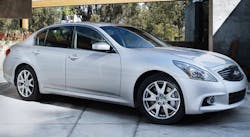There was a time when broad-line tires were broad-line tires and performance tires were performance tires, and the two categories rarely, if ever, intersected. Those simple days are long gone, according to tire manufacturers.
Thanks to the growing number of cars rolling off the assembly line with large diameter, low aspect ratio tires, “the lines (between tire segments) are absolutely blurred right now,” says Travis Roffler, director of marketing for Continental Tire the Americas LLC. “225/60R16 is the new 195/75R14.”
Where does that leave the broad-line segment? In a state of flux, says Rick Brennan, vice president of marketing for Kumho Tire U.S.A. Inc.
“The traditional broad-line segment — 13 inches to 16 inches and 70- to 75-series — has shrunk, not because there are fewer consumers in it, but because cars have evolved. From a tire dealer’s point of view, the marketplace is getting more size-oriented and less segment-oriented.”
[PAGEBREAK]
Does broad-line mean entry-level?
“The broad-line segment doesn’t fit one (vehicle) segment anymore,” says Brennan. “It fits sizes, and the grouping of sizes is different.
“When you think of entry-level, you always think of a base model, everyday car. Now it can be any type of vehicle. You can buy a Honda Accord that comes with a 65-series tire, and there are still some high-priced tires that are defined as broad-line.
“Take a size like 225/60R18 for the Chrysler 300,” he continues. “You see a lot of that size in broad-line products now. That line may also have a 15-inch, 70-series offering... it’s the same tread pattern, but a Chrysler 300 really isn’t an entry-level car. So now you have a lot of distance in product lines.
“Go back 20 years: when you defined ultra-high performance, it was high performance tires for sports cars. That’s no longer the case today. And that’s what has happened to the industry. It has caused size proliferation and type proliferation, and unfortunately, it isn’t going to stop anytime soon.”
All things to more people
Roffler says it’s not uncommon for car manufacturers to spec a single tire size with both an S and V speed rating.
This presents challenges for both tire dealers and manufacturers, he explains.
From a manufacturing standpoint, “the hardest decision is (determining) what lines to put what sizes in because you can’t do everything. The challenge for us is, ‘Can we build it all and be competitive, and what can be done to make sure the dealer has everything he needs to serve his customers?’”
[PAGEBREAK]
Brennan says his company, Kumho, grapples with the same questions. “The broad-line segment is touching a lot of places it didn’t touch before. The growth in the marketplace of high performance and ultra-high performance... means we have to put long mileage, good comfort and good snow traction into tire sizes we never would have in the past.
“Within the next five to six years, I think you’re going to see huge changes in the distribution styles of manufacturers and distributors. There are distributors out there who will not be able to handle size proliferation.
“If a customer drives in and wants one of these sizes,” he continues, “the dealer will have to have it, so the way he gets tires and how fast he gets them will have to evolve over time.”
The average amount of time between the moment a customer decides he wants to buy replacement tires and the moment he enters a tire dealership to actually make the purchase is a mere six hours, according to Roffler, as opposed to six days some 10 years ago.
Customers just don’t want to wait anymore, he says.
His advice to dealers? “You need to hold a basic stock of the most popular sizes. And if you’re a small retailer, you have to find a good distributor who can deliver tires to you on a daily basis.”
It won’t simplify all of the complexities caused by the melding of broad-line and performance, but it’s a start, he adds ■



